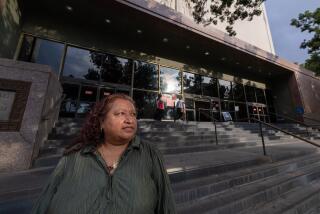Applicants for Public Housing Face Longer Wait : Government: A federal directive drops many senior citizens and families further down the list.
- Share via
Eighty-year-old Alfred Poitras of Ojai spends his days in a motel room, waiting for the time he can leave his small room and hot plate for a one-bedroom apartment in Ojai’s low-income senior housing complex.
Almost 2 1/2 years have passed since Poitras applied to move into Whispering Oaks, a 99-unit facility for self-supporting senior citizens.
When he checked Oct. 13, he was told that he was No. 13 on the waiting list, so he gave up his apartment and took a room at the motel to await his move.
On Nov. 16, Poitras went again to the Area Housing Authority’s Camarillo office to see how close he was to moving. But to his dismay, his name was headed in the wrong direction on the waiting list. Instead of moving closer to the top, he had fallen back to 219.
Many of the 2,400 Ventura County senior citizens and families waiting to move into low-income housing are finding themselves in the same boat as Poitras.
Twenty years ago, to avoid having to set up seven different programs, the cities of Ojai, Camarillo, Fillmore, Moorpark, Simi Valley, Thousand Oaks and the county’s unincorporated areas contracted with the Area Housing Authority to administer waiting lists for the low-income complexes funded by the federal Department of Housing and Urban Development.
The Area Housing Authority then set up individual waiting lists for the seven areas, said Tom Ristau, grants coordinator for Fillmore.
The problem is that no one realized, until recently, that unless a housing authority gets a waiver, it may not keep separate lists for each community.
“In July of this year, the Area Housing Authority was informed by HUD that unless the lists were combined, they would not receive 1992-93 housing program funding,” Ristau said. “Because of this, the housing authority complied.”
Poitras and others like him were left in limbo.
“I don’t know what I’m going to do or where I’ll go,” he said.
He is still at the Ojai motel, even though most of his $638-a-month income is spent on rent. What is left over is spent on food and the medication he must take since undergoing three major operations in the past three years.
In Thousand Oaks, a family that had been preparing to move learned that they, too, had been pushed back down the list.
“There is a family with kids, and they are living in their car,” said Olav Hassel, Thousand Oaks housing services manager. “They were next in line to move into Leggit Court and now they are number 60.”
Dave Roddick, the Area Housing Authority’s director of housing management, speculated that most of those who moved up on the list are from Simi Valley, Fillmore or Moorpark, which have no public housing. Before the lists were combined, residents of those cities were wait-listed behind residents of cities with public housing.
The housing authority has filed an application to obtain a waiver for the single list regulation, but it could take several months for HUD to reach a decision on the application, said John Phillips, a HUD spokesman.
However, with the change in administrations in Washington quickly approaching, officials hope to have HUD Secretary Jack Kemp review the situation before he leaves office, Rep. Elton Gallegly (R-Simi Valley) said.
“I met with the housing authority two weeks ago and I requested from them to get me a summary from each of the affected cities outlining the effect that this situation was presenting to them,” he said.
Gallegly then faxed the letters to Kemp in hopes that he could read them over before the end of the year.
“We are right at the wire. Jack Kemp will not be in a decision-making position for long, and it could take awhile for the new team to get their feet in place,” he said. “I would like to get this done before we are in that situation.”
In addition to the changes in position on the waiting list, county officials cite a second problem with the new method: Residents could lose the chance to move into housing in their own back yard.
When housing comes open anywhere in the county, the person at the top of the list must take it quickly.
“They can reject a vacancy three times and, after that, they are dropped from the list,” Roddick said.
While some residents may be able to accept housing in another community, those like Poitras have established support systems in their own community.
“Most seniors have support groups made up of family, friends, doctors, pharmacists, stores. They may not want to move from one community to another,” Roddick said. “HUD may not be aware that living in Ojai is a whole lot different than living in Thousand Oaks.”
Gallegly agreed. “It is ludicrous to mandate to someone living in Simi Valley that if they have a need for housing and a unit comes up in Ojai, and if they don’t take it, they get dropped. Folks that are on public housing lists are not people that normally can afford to move around.”
Gallegly hopes that Kemp’s ties to the county help in rectifying the problem.
“We have a good relationship with Kemp. His mother-in-law lives in Fillmore, one of the cities involved,” he said. “So not only do I have a good relationship with him, but he knows the area, which should help us a bit.”
While the situation continues to cause hardships for county residents, officials throughout the county hope that the housing authority can return to seven separate lists.
“Our hope is that we can resolve this with HUD so that someone like Poitras can go back to their original position on the list and possibly move into housing in about the same amount of time as they originally would have,” said Dan Singer, administrative assistant for Ojai.
But Poitras believes that time is running out for him and others.
“We will never make it. We are at that age where we have little time left,” he said.
More to Read
Sign up for Essential California
The most important California stories and recommendations in your inbox every morning.
You may occasionally receive promotional content from the Los Angeles Times.










